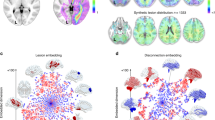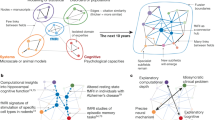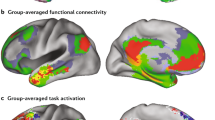Abstract
Recent technological advances, such as functional imaging techniques, allow neuroscientists to measure and localize brain activity in healthy individuals. These techniques avoid many of the limitations of the traditional method for inferring brain function, which relies on examining patients with brain lesions. This has fueled the zeitgeist that the classical lesion method is an inferior and perhaps obsolescent technique. However, although the lesion method has important weaknesses, we argue that it complements the newer activation methods (and their weaknesses). Furthermore, recent developments can address many of the criticisms of the lesion method. Patients with brain lesions provide a unique window into brain function, and this approach will fill an important niche in future research.
This is a preview of subscription content, access via your institution
Access options
Subscribe to this journal
Receive 12 print issues and online access
$189.00 per year
only $15.75 per issue
Buy this article
- Purchase on Springer Link
- Instant access to full article PDF
Prices may be subject to local taxes which are calculated during checkout





Similar content being viewed by others
References
Broca, P. Remarques sur le siège de la faculté du langage articulé suivies d'une observation d'aphémie (perte de la parole). Bull. Soc. Anat. 6, 330–357 (1861).
Wernicke, C. Der Aphasische Symptomencomplex (Cohn and Weigert, Breslau, 1874).
Scoville, W. B. & Milner, B. Loss of recent memory after bilateral hippocampal lesions. J. Neurol. Neurosurg. Psychiatry 20, 11–21 (1957).
Sperry, R. W., Gazzaniga, M. S. & Bogen, J. E. in Handbook of Clinical Neurology (eds Vinken, P. J. & Bruyn, G. W.) 273–290 (John Wiley and Sons, New York, 1969).
Adolphs, R., Tranel, D., Damasio, H. & Damasio, A. R. Fear and the human amygdala. J. Neurosci. 15, 5879–5891 (1995).
Calder, A. J., Keane, J., Manes, F., Antoun, N. & Young, A. Impaired recognition and experience of disgust following brain injury. Nature Neurosci. 3, 1077–1078 (2000).
Goodale, M. A. & Milner, A. D. Separate visual pathways for perception and action. Trends Neurosci. 15, 20–25 (1992).
Amunts, K. et al. Analysis of neural mechanisms underlying verbal fluency in cytoarchitectonically defined stereotaxic space—the roles of Brodmann areas 44 and 45. Neuroimage 22, 42–56 (2004).
Frey, R., Woods, D. L., Knight, R. T. & Scabini, D. Defining functional cortical areas with 'averaged' CT scans. Soc. Neurosci. Abstr. 13, 1266 (1987).
Hayward, R. W., Naeser, M. A. & Zatz, L. M. Cranial computed tomography in aphasia- correlation of anatomical lesions with functional deficits. Radiology 123, 653–660 (1977).
Kertesz, A., Harlock, W. & Coates, R. Computer tomographic localization, lesion size, and prognosis in aphasia and nonverbal impairment. Brain Lang. 8, 34–50 (1979).
Damasio, H. & Damasio, A. R. Lesion Analysis in Neuropsychology (Oxford Univ. Press, New York, 1989).
Farah, M. J. Neuropsychological inference with an interactive brain: a critique of the locality assumption. Behav. Brain Sci. 17, 43–61 (1994).
Miller, E. K. The prefrontal cortex and cognitive control. Nature Rev. Neurosci. 1, 59–65 (2000).
Freedman, D. J., Riesenhuber, M., Poggio, T. & Miller, E. K. Categorical representation of visual stimuli in the primate prefrontal cortex. Science 291, 312–316 (2001).
Heinsius, T., Bogousslavsky, J. & Van Melle, G. Large infarcts in the middle cerebral artery territory. Etiology and outcome patterns. Neurology 50, 341–350 (1998).
Raineteau, O. & Schwab, M. E. Plasticity of motor systems after incomplete spinal cord injury. Nature Rev. Neurosci. 2, 263–273 (2001).
Caviness, V. S. et al. Anatomy of stroke, part I: an MRI-based topographic and volumetric system of analysis. Stroke 33, 2549–2556 (2002).
Sarter, M., Berntson, G. G. & Cacioppo, J. T. Brain imaging and cognitive neuroscience: toward strong inference in attributing function to structure. Am. Psychol. 51, 13–21 (1996).
Petersen, S. E., Fox, P. T., Posner, M. I., Mintun, M. & Raichle, M. E. Positron emission tomographic studies of the cortical anatomy of single-word processing. Nature 331, 585–589 (1988).
Karbe, H. et al. Planum temporale and Brodmann's area 22. Magnetic resonance imaging and high-resolution positron emission tomography demonstrate functional left-right asymmetry. Arch. Neurol. 52, 869–874 (1995).
Lehéricy, S. et al. Functional MR evaluation of temporal and frontal language dominance compared with the Wada test. Neurology 54, 1625–1633 (2000).
Fernández, G. et al. Language mapping in less than 15 minutes: real-time functional MRI during routine clinical investigation. Neuroimage 14, 585–594 (2001).
Blank, S. C., Scott, S. K., Murphy, K., Warburton, E. & Wise, R. J. Speech production: Wernicke, Broca and beyond. Brain 125, 1829–1838 (2002).
Crinion, J. T., Lambon-Ralph, M. A., Warburton, E. A., Howard, D. & Wise, R. J. S. Temporal lobe regions engaged during normal speech comprehension. Brain 126, 1193–1201 (2003).
Josse, G. & Tzourio-Mazoyer, N. Hemispheric specialization for language. Brain Res. Rev. 44, 1–12 (2004).
Ojemann, J. G., Ojemann, G. A. & Lettich, E. Cortical stimulation mapping of language cortex by using a verb generation task: effects of learning and comparison to mapping based on object naming. J. Neurosurg. 97, 33–38 (2002).
Rasmussen, T. M. in Cerebral Localization (eds Zulch, K. J., Creutzfeldt, O. & Galbraith, G. C.) 238–257 (Springer, Berlin, 1975).
Wada, J. & Rasmussen, T. Intracarotid injection of sodium amytal for the lateralization of cerebral speech dominance: experimental and clinical observations. J. Neurosurg. 17, 266–282 (1960).
Woermann, F. G. et al. Language lateralization by Wada test and fMRI in 100 patients with epilepsy. Neurology 61, 699–701 (2003).
Hund-Georgiadis, M., Lex, U., Friederici, A. D. & von Cramon, D. Y. Non-invasive regime for language lateralization in right- and left-handers by means of functional MRI and dichotic listening. Exp. Brain Res. 145, 166–176 (2002).
Papanicolaou, A. C. et al. Magnetocephalography: a noninvasive alternative to the Wada procedure. J. Neurosurg. 100, 867–876 (2004).
Le Bihan, D. Looking into the functional architecture of the brain with diffusion MRI. Nature Rev. Neurosci. 4, 469–480 (2003).
Ricci, P. E., Burdette, J. H., Elster, A. D. & Reboussin, D. M. A comparison of fast spin-echo, fluid-attenuated inversion-recovery, and diffusion-weighted MR imaging in the first 10 days after cerebral infarction. Am. J. Neuroradiol. 20, 1535–1542 (1999).
Noguchi, K. et al. MRI of acute cerebral infarction: a comparison of FLAIR and T2- weighted fast spin-echo imaging. Neuroradiology 39, 406–410 (1997).
Brant-Zawadzki, M., Atkinson, D., Detrick, M., Bradley, W. G. & Scidmore, G. Fluid-attenuated inversion recovery (FLAIR) for assessment of cerebral infarction: initial clinical experience in 50 patients. Stroke 27, 1187–1191 (1996).
Schaefer, P. W. et al. Predicting cerebral ischemic infarct volume with diffusion and perfusion MR imaging. Am. J. Neuroradiol. 23, 1785–1794 (2002).
D'Esposito, M., Deouell, L. Y. & Gazzaley, A. Alterations in the bold fMRI signal with ageing and disease: a challenge for neuroimaging. Nature Rev. Neurosci. 4, 863–872 (2003).
Hillis, A. E. et al. Subcortical aphasia and neglect in acute stroke: the role of cortical hypoperfusion. Brain 125, 1094–1104 (2002).
Poeck, K., De Bleser, R. & Graf von Keyserlingk, D. Neurolinguistic status and localization of lesion in aphasic patients with exclusively consonant-vowel recurring utterances. Brain 107, 199–217 (1984).
Mohr, J. P. et al. Broca aphasia: pathologic and clinical. Neurology 28, 311–324 (1978).
Willmes, K. & Poeck, K. To what extent can aphasic syndromes be localized. Brain 116, 1527–1540 (1993).
Dronkers, N. F., Redfern, B. B. & Knight, R. T. in The New Cognitive Neurosciences (ed. Gazzaniga, M.) 949–958 (MIT Press, Cambridge, Massachusetts, 2000).
Dronkers, N. F. A new brain region for coordinating speech articulation. Nature 384, 159–161 (1996).
Blunk, R., De Bleser, R., Willmes, K. & Zeumer, H. A refined method to relate morphological and functional-aspects of aphasia. Eur. Neurol. 20, 69–79 (1981).
Poeck, K., De Bleser, R. & Graf von Keyserlingk, D. Computed tomography localization of standard aphasic syndromes. Adv. Neurol. 42, 71–89 (1984).
Weiller, C., Ringelstein, E. B., Reiche, W., Thron, A. & Buell, U. The large striatocapsular infarct: a clinical and pathophysiological entity. Arch. Neurol. 47, 1085–1091 (1990).
Weiller, C. et al. The case of aphasia or neglect after striatocapsular infarction. Brain 116, 1509–1525 (1993).
Adolphs, R., Damasio, H., Tranel, D., Cooper, G. & Damasio, A. R. A role for somatosensory cortices in the visual recognition of emotion as revealed by three-dimensional lesion mapping. J. Neurosci. 20, 2683–2690 (2000).
Karnath, H. O., Himmelbach, M. & Rorden, C. The subcortical anatomy of human spatial neglect: putamen, caudate nucleus and pulvinar. Brain 125, 350–360 (2002).
Rorden, C. & Brett, M. Stereotaxic display of brain lesions. Behav. Neurol. 12, 191–200 (2000).
Frank, R. J., Damasio, H. & Grabowski, T. J. Brainvox: an interactive, multimodal visualization and analysis system for neuroanatomical imaging. Neuroimage 5, 13–30 (1997).
Bates, E. et al. Voxel-based lesion-symptom mapping. Nature Neurosci. 6, 448–450 (2003).
Benjamini, Y. & Hochberg, Y. Controlling the false discovery rate: a practical and powerful approach to multiple testing. J. R. Stat. Soc. Ser. B 57, 289–300 (1995).
Yekutieli, D. & Benjamini, Y. Resampling-based false discovery rate controlling multiple test procedures for correlated test statistics. J. Stat. Plan. Inf. 82, 171–196 (1999).
Price, C. J. & Friston, K. J. Degeneracy and cognitive anatomy. Trends Cogn. Sci. 6, 416–421 (2002).
Husain, M. & Rorden, C. Non-spatially lateralized mechanisms in hemispatial neglect. Nature Rev. Neurosci. 4, 26–36 (2003).
Pascual-Leone, A., Bartres-Faz, D. & Keenan, J. P. Transcranial magnetic stimulation: studying the brain-behaviour relationship by induction of 'virtual lesions'. Philos. Trans. R. Soc. Lond. B 354, 1229–1238 (1999).
Walsh, V. & Cowey, A. Transcranial magnetic stimulation and cognitive neuroscience. Nature Rev. Neurosci. 1, 73–79 (2000).
Sack, A. T. & Linden, D. E. Combining transcranial magnetic stimulation and functional imaging in cognitive brain research: possibilities and limitations. Brain Res. Rev. 43, 41–56 (2003).
Brett, M., Johnsrude, I. S. & Owen, A. M. The problem of functional localization in the human brain. Nature Rev. Neurosci. 3, 243–249 (2002).
Brett, M., Leff, A. P., Rorden, C. & Ashburner, J. Spatial normalization of brain images with focal lesions using cost function masking. Neuroimage 14, 486–500 (2001).
Signoret, J. L., Castaigne, P., Lhermitte, F., Abelanet, R. & Lavorel, P. Rediscovery of Leborgne brain: anatomical description with CT scan. Brain Lang. 22, 303–319 (1984).
Heilman, K. M., Watson, R. T., Valenstein, E. & Damasio, A. R. in Localization in Neuropsychology (ed. Kertesz, A.) 471–482 (Academic, New York, 1983).
Martin, J. H. Neuroanatomy: Text and Atlas 2nd edn (Appleton & Lange, Stamford, Connecticut, 1996).
Karnath, H. O., Fruhmann Berger, M., Küker, W. & Rorden, C. The anatomy of spatial neglect based on voxelwise statistical analysis: a study of 140 patients. Cereb. Cortex (in the press).
Acknowledgements
This work was supported by grants from the National Institutes of Health and the Deutsche Forschungsgemeinschaft. We would also like to thank M. Himmelbach for his insightful comments.
Author information
Authors and Affiliations
Corresponding author
Ethics declarations
Competing interests
The authors declare no competing financial interests.
Related links
Related links
FURTHER INFORMATION
Encyclopedia of Life Sciences
Brain imaging as a diagnostic tool
Brain imaging: observing ongoing neural activity
BrainVox
Rights and permissions
About this article
Cite this article
Rorden, C., Karnath, HO. Using human brain lesions to infer function: a relic from a past era in the fMRI age?. Nat Rev Neurosci 5, 812–819 (2004). https://doi.org/10.1038/nrn1521
Issue Date:
DOI: https://doi.org/10.1038/nrn1521
This article is cited by
-
A framework for focal and connectomic mapping of transiently disrupted brain function
Communications Biology (2023)
-
Neuroanatomy of reduced distortion of body-centred spatial coding during body tilt in stroke patients
Scientific Reports (2023)
-
Using causal methods to map symptoms to brain circuits in neurodevelopment disorders: moving from identifying correlates to developing treatments
Journal of Neurodevelopmental Disorders (2022)
-
Causal mapping of human brain function
Nature Reviews Neuroscience (2022)
-
Contribution of the medial eye field network to the voluntary deployment of visuospatial attention
Nature Communications (2022)



